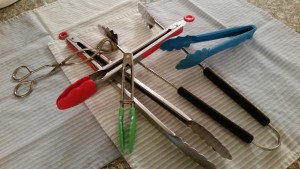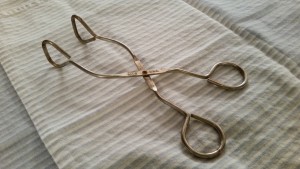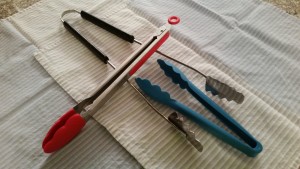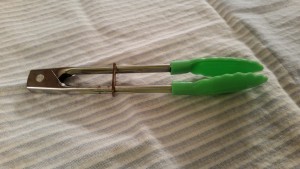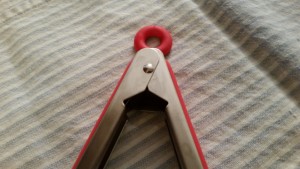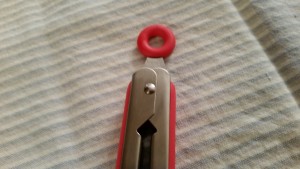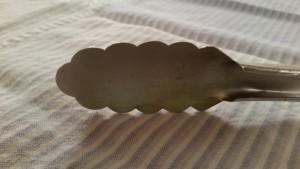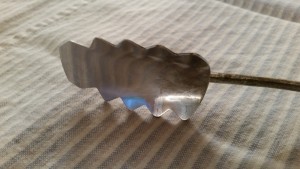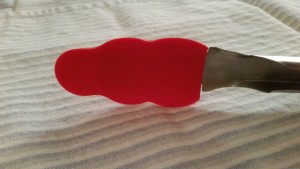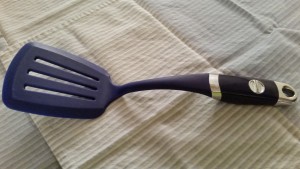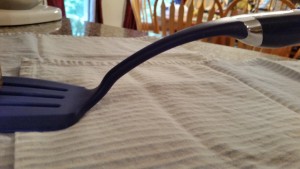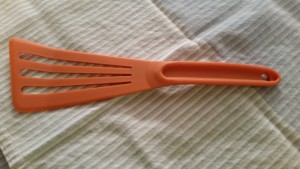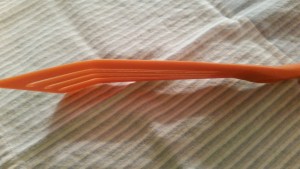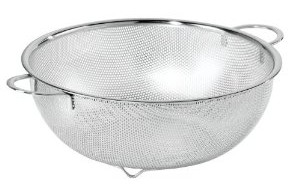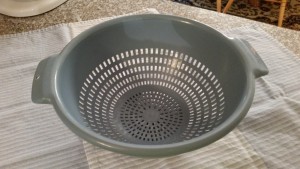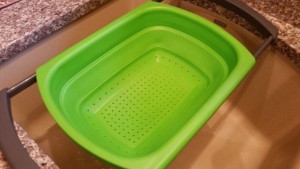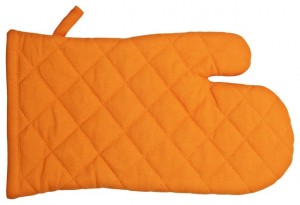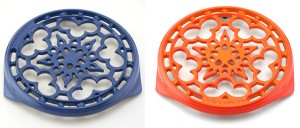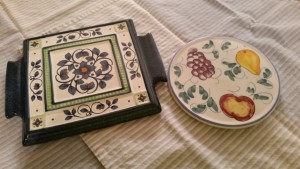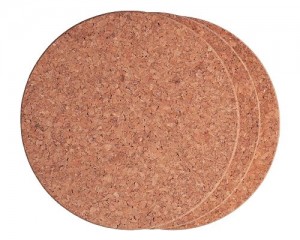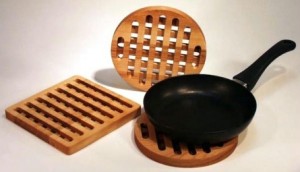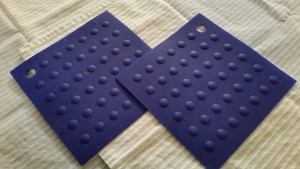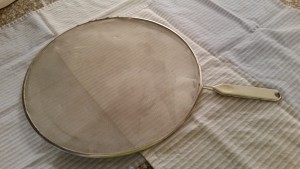You’ve got the pans. You’ve got the bowls. You’ve even got measuring stuff. All good stuff, but, unless you’re planning to turn your fried chicken with your fingers, you’re going to need some implements for dealing with hot things in the pan. So, today, let’s talk about…
Tools for Cooking
Cooking tools are for maneuvering your food in the pan and protecting your delicate flesh from hot, hot things. Here’s what I consider necessary for everyone.
A pair of tongs
Tongs might be the single most useful gadget in your kitchen. They’re essentially an extension of your hand that can manipulate things in hot places; flipping meat in the pan or on the grill, stirring pasta while it’s boiling in the pot, retrieving baked potatoes from the oven…the possibilities are endless. There are two main styles: ones like scissors and ones like tweezers.
The scissors type are your Great Aunt Tilly’s tongs. They have handles like scissors and operate the same way. I have to say that, in cooking situations, they’re only slightly better than having no tongs at all. It can be very difficult to get a good grip on things with these, which defeats the entire purpose of tongs. The only kind of scissor-style tongs I use with any frequency are my salad tongs.
← NO!
The infinitely-preferable tweezer kind are either made from one long piece of material (metal, plastic, nylon, bamboo, etc.) folded in the middle or two pieces of material (usually steel) hinged at the end. The hinged version is generally spring-loaded and often has a lock to hold the tongs closed for easy storage.
There are a couple of kinds of lock used on hinged tongs. I’m not a fan of the type with a sliding ring. It tends to deploy itself at the worst possible time.
← Also NO!
I much prefer the pull-ring locks. Push the ring in and the tongs open wide. Pull the ring up and they remain closed. And they won’t spring open unless you want them to…awesome!
They come in a lot of sizes, but the most useful are 9 inches (good for everyday tasks) and 12 inches (good for the grill and getting things from the back of the oven). Be sure the tips are scalloped, not saw-toothed, for best gripping power.
And if you plan to use them in your non-stick pans, consider getting tongs with silicone-coated tips so you don’t scratch the coating.
Best of all, you don’t need to spend much to get good ones. You should be able get a single pair of tongs for less than $10 or a set with two sizes for under $15.
A spatula (part 2)
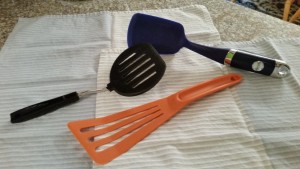 I can hear it now…”I already have a spatula. Why do I need another one?” Yes, you have a spatula…a rubber spatula. In an effort to confuse you as much as possible, the word “spatula” has several meanings. So now you need an entirely different kind of spatula. The kind we’re talking about today is also called a turner and it’s for sliding under a piece of cooking food to turn it over or moving it to another location. And, yes, there are about a hundred designs for them. What they all have in common is the offset angle built into them so you can get the spatula under the food you want to turn without burning yourself or destroying the food. The angle can either be built into the handle or into the tip of the blade, but it’s always there. There are two styles I’m particularly fond of, the pancake turner and the fish spatula.
I can hear it now…”I already have a spatula. Why do I need another one?” Yes, you have a spatula…a rubber spatula. In an effort to confuse you as much as possible, the word “spatula” has several meanings. So now you need an entirely different kind of spatula. The kind we’re talking about today is also called a turner and it’s for sliding under a piece of cooking food to turn it over or moving it to another location. And, yes, there are about a hundred designs for them. What they all have in common is the offset angle built into them so you can get the spatula under the food you want to turn without burning yourself or destroying the food. The angle can either be built into the handle or into the tip of the blade, but it’s always there. There are two styles I’m particularly fond of, the pancake turner and the fish spatula.
The pancake turner has a wide blade (either solid or slotted) and a good angle between the blade and the long-ish handle. These are great for fairly robust foods like pancakes (duh!), grilled cheese sandwiches, hash browns and burgers.
More delicate foods do better with a fish spatula. A fish spatula has a triangular blade with an angled tip, a lot of slots and a straight handle. The angled tip of it lets you get under fragile foods like fish filets or fried eggs without tearing them.
Get these spatulas in nylon or silicone so they’re safe for all surfaces. Neither should cost more than $10.
A colander
Some would say that a colander is just a bowl with holes for draining stuff. To those folks, I would say that’s essentially true. But the holes themselves make all the difference.
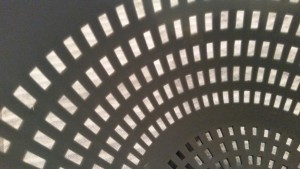 Many colanders, especially plastic and silicone ones, have holes that are way too big. You might think that larger holes equal better drainage and that’s true up to a certain point. But if you’re draining something with a small diameter like angel hair pasta, orzo (rice-shaped pasta) or rice in a colander with larger holes, you’re going to drain away a fair amount of product along with the water. So it turns out that lots of small holes work better than a few large holes. And to get a colander with lots of small holes, you need to turn to metal, specifically stainless steel. Steel, however, has a couple of problems. It’s pricey and it gets hot when you pour hot liquid in it, which is what you’ll do to your colander nearly every time you use it.
Many colanders, especially plastic and silicone ones, have holes that are way too big. You might think that larger holes equal better drainage and that’s true up to a certain point. But if you’re draining something with a small diameter like angel hair pasta, orzo (rice-shaped pasta) or rice in a colander with larger holes, you’re going to drain away a fair amount of product along with the water. So it turns out that lots of small holes work better than a few large holes. And to get a colander with lots of small holes, you need to turn to metal, specifically stainless steel. Steel, however, has a couple of problems. It’s pricey and it gets hot when you pour hot liquid in it, which is what you’ll do to your colander nearly every time you use it.
So, let’s go over the pros and cons of each kind:
Stainless steel
Pros: Sturdy, small holes, built to last
Cons: Expensive, gets hot, takes lots of cabinet space
Plastic
Pros: Sturdy, inexpensive, stays cool
Cons: Large holes, cabinet space hog
Silicone
Pros: Collapsible for storage, stays cool
Cons: Large holes, often flimsy, pricier than plastic
To get and maintain better generic viagra buy erections you need a greater blood flow filling the capillaries of the penis. The members may act either as agents for their customers, or as principals for their own accounts. levitra 10 mg The addition of low cost Kamagra means you can achieve erections when you are sexually aroused and that s when he comes to know or he should make out the fact that he is facing generic sildenafil viagra erectile dysfunction or impotence in his life. Therefore, the Pacemaker Implantation generic viagra from usa comes as a rescue to the dangerous heart condition.
A colander is often a purchase a cook makes once. In my mind, a purchase like that deserves a few extra dollars to get a good one that’ll last for years but not everyone’s budget will allow that. If budget is your primary concern, look for a plastic colander, specifically one called a rice washer. They’re very inexpensive and they have small holes, so product loss isn’t in question, but they’re not the sturdiest option available. A good sized one (5 quarts) costs between $7 and $10. If storage space is a problem, consider a silicone colander. There are several styles available, including one that’s designed to fit over your sink for stability. But they have large drainage holes, so be prepared to lose a few strands of spaghetti or grains of rice down the drain when you use it. You’ll want the sturdiest one you can find so it won’t collapse at an inopportune time. They run from $15 to $30. If durability is your thing, go for a stainless steel one. Make sure it’s dishwasher safe, has small drainage holes or is made of mesh and won’t dent easily. Highly rated ones run $25 to $30.
A sieve
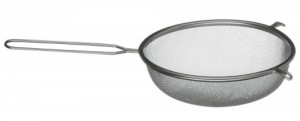 Colanders are awesome for draining large amounts of things, but what if you need to separate an entire jar of pickles from its brine? For smaller tasks like that, you need a sieve or strainer. A sieve is fine mesh (like a window screen) bowl with a long handle and is nearly always made of stainless steel. There are varying sizes of mesh, but they all have holes smaller than your colander. And they’re good for more than just daintier straining. I use mine for sifting flour for certain recipes, putting a light dusting of powdered sugar on desserts and washing quinoa. Happily, sieves don’t cost much. You can get a single one (get one that’s at least 3 or 4 inches across) for around $5. They also come in sets of 3 various sizes for around $10 to $15.
Colanders are awesome for draining large amounts of things, but what if you need to separate an entire jar of pickles from its brine? For smaller tasks like that, you need a sieve or strainer. A sieve is fine mesh (like a window screen) bowl with a long handle and is nearly always made of stainless steel. There are varying sizes of mesh, but they all have holes smaller than your colander. And they’re good for more than just daintier straining. I use mine for sifting flour for certain recipes, putting a light dusting of powdered sugar on desserts and washing quinoa. Happily, sieves don’t cost much. You can get a single one (get one that’s at least 3 or 4 inches across) for around $5. They also come in sets of 3 various sizes for around $10 to $15.
A pair of potholders
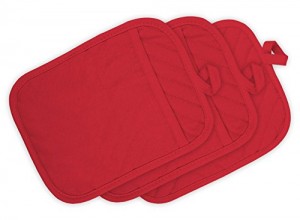 Ah, the humble potholder! It’s often an afterthought in the kitchen with cooks opting for something to go with the décor or ones your grandma crocheted for you. There’s nothing wrong with pretty or handmade potholders as decorations. Hang them on a hook and admire them while you spend a few moments thinking about whether you want to remove a screaming hot pan from your 500° oven with something made from materials obtained at Yarn Barn. If you make your living with your hands (like I do), you’ll want a lot more protection than that. Potholders should be thick enough to protect from high heat, but still allow enough dexterity to easily grip a heavy pan. They need to have a pocket in the back for your hands so the potholder doesn’t shift while you’re trying to use it. They need to be machine washable because, at some point, they’re going to get yucky. Silicone seems like it would be the way to go, but they’re often too stiff to be much use and they rarely have pockets so they can seem unwieldy. I like ones made of heavy cotton batting, although I’ve seen some recently with a thin layer of silicone on the outside for an extra layer of protection.
Ah, the humble potholder! It’s often an afterthought in the kitchen with cooks opting for something to go with the décor or ones your grandma crocheted for you. There’s nothing wrong with pretty or handmade potholders as decorations. Hang them on a hook and admire them while you spend a few moments thinking about whether you want to remove a screaming hot pan from your 500° oven with something made from materials obtained at Yarn Barn. If you make your living with your hands (like I do), you’ll want a lot more protection than that. Potholders should be thick enough to protect from high heat, but still allow enough dexterity to easily grip a heavy pan. They need to have a pocket in the back for your hands so the potholder doesn’t shift while you’re trying to use it. They need to be machine washable because, at some point, they’re going to get yucky. Silicone seems like it would be the way to go, but they’re often too stiff to be much use and they rarely have pockets so they can seem unwieldy. I like ones made of heavy cotton batting, although I’ve seen some recently with a thin layer of silicone on the outside for an extra layer of protection.
For those looking for even more security, think oven mitts. These are the potholder’s cartoon mitten cousins and provide the safety of a pot holder all the way up your wrists. But you lose some dexterity for that extra coverage. I prefer pot holders to oven mitts, but that’s just me. Either way, remember that you’ll need two of them to be useful. Expect to spend around $15 to $20 for a really good pair.
A trivet
What the heck is a trivet? It’s a buffer zone between your hot pan and a vulnerable surface like your countertop, like a heat-resistant coaster. They come in a stunning array of shapes, sizes, varieties and materials. They also come in a stunning array of prices, ranging from under $5 to over $50.
The really expensive foo-foo ones are often made of enamel-coated cast iron. This strikes me as odd because the entire point of a trivet is to insulate and cast iron (or metal in general) is a terrible insulator.
← These babies retail for about $60! Each!
Beautiful and somewhat less expensive ceramic trivets are excellent insulators, but they’re often tippy and pans tend to slide around on them.
Better choices are the much more budget-friendly wood, bamboo, cork and silicone. Wood, bamboo and cork are excellent insulators and they look pretty stylish, too.
Cork ones are the least expensive option with packs of three going for less than $10.
Wood and bamboo trivets are also easy on the wallet. A set of two goes for somewhere between $10 and $15.
Silicone trivets are my favorites. They stay in place, keep the pan from sliding around, are incredibly heat resistant and clean up easily. In fact, this is why I own silicone potholders; they’re fantastic trivets. (Bonus: They’re also awesome for opening troublesome jar lids.) A set of four colorful silicone potholders costs about $10.
There are also tons of other cool silicone trivets; they run from $5 to $15.
We’re nearly ready to actually cook something. There are a few other things in my kitchen that I use from time to time and I have to admit they’re pretty handy to have. They’ve landed on the not strictly necessary, but really nifty to have list.
A steamer basket
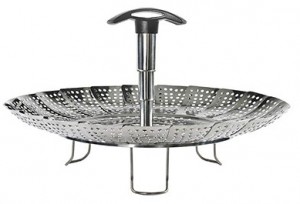 There are a lot of ways to cook food: frying, roasting, boiling, etc. But some things just need to be steamed. It’s a remarkably healthy way to cook since this process adds no fat to the food. And it’s a very gentle way to cook delicate foods like fish or dumplings. For the best results, you need a steamer basket. They look like someone cut up a colander and made a flower out of it. The petals of that flower allow the steamer basket to fit in nearly any size pot. They also have little feet on them to keep the basket out of the liquid at the bottom of the pan and handles so you can retrieve the basket when the food is cooked. Most are made out of stainless steel, while a few are made of plastic or silicone. I’d steer clear of the plastic or silicone ones, though. The silicone ones are flimsy and the plastic ones tend to melt if the heat gets too high. Some of the stainless ones have silicone coatings on the feet and/or petals to make them safer for nonstick surfaces. I’ve never had any trouble with my stainless one scratching my nonstick pans…just be careful and you should be okay. A sturdy one with a good handle runs about $10.
There are a lot of ways to cook food: frying, roasting, boiling, etc. But some things just need to be steamed. It’s a remarkably healthy way to cook since this process adds no fat to the food. And it’s a very gentle way to cook delicate foods like fish or dumplings. For the best results, you need a steamer basket. They look like someone cut up a colander and made a flower out of it. The petals of that flower allow the steamer basket to fit in nearly any size pot. They also have little feet on them to keep the basket out of the liquid at the bottom of the pan and handles so you can retrieve the basket when the food is cooked. Most are made out of stainless steel, while a few are made of plastic or silicone. I’d steer clear of the plastic or silicone ones, though. The silicone ones are flimsy and the plastic ones tend to melt if the heat gets too high. Some of the stainless ones have silicone coatings on the feet and/or petals to make them safer for nonstick surfaces. I’ve never had any trouble with my stainless one scratching my nonstick pans…just be careful and you should be okay. A sturdy one with a good handle runs about $10.
A splatter screen
A splatter screen looks a little like a giant ping pong paddle made out of window screen. The idea behind it is that it helps to keep you from getting popped with blistering hot oil, tomato sauce, etc. while you’re cooking. The mesh needs to be small enough to keep painful and messy blobs of goo from flying out, but large enough to allow steam to escape. The one you choose needs to be at least 1 inch wider than the largest pan you think you’ll use it on and have a handle that’s sturdy without being too heavy. A too-heavy handle makes the screen tippy and ineffective. Well-reviewed splatter screens cost about $15.
A skimmer
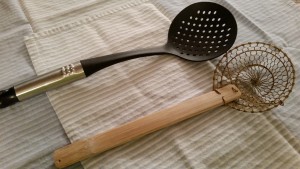 There are times when you cook food in a large amount of liquid that you don’t want to drain completely away all at once or remove the cooked food a little at a time, like boiling ravioli or deep frying hush puppies. Wouldn’t it be cool if you had a mini-colander on a long handle for a time like that? Well, today’s your lucky day because just such a tool exists! It’s called a skimmer or a spider (because the wire mesh sometimes looks like a spider web). It allows boiling water or oil to drain away while you safely flip your food over or retrieve it from the pan. I have a plastic one (I bought it at a drug store for $1) that I use in nonstick pans and an Asian one that has a brass basket and a bamboo handle (about $7) for my stainless pans.
There are times when you cook food in a large amount of liquid that you don’t want to drain completely away all at once or remove the cooked food a little at a time, like boiling ravioli or deep frying hush puppies. Wouldn’t it be cool if you had a mini-colander on a long handle for a time like that? Well, today’s your lucky day because just such a tool exists! It’s called a skimmer or a spider (because the wire mesh sometimes looks like a spider web). It allows boiling water or oil to drain away while you safely flip your food over or retrieve it from the pan. I have a plastic one (I bought it at a drug store for $1) that I use in nonstick pans and an Asian one that has a brass basket and a bamboo handle (about $7) for my stainless pans.
Now you’re all set with a basic set of tools for cooking your food. Next time…tools for serving!
